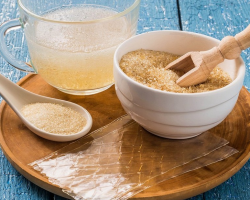The reasons for the turning and greening of garlic during pickling, salting, frying, extinguishing vegetables, mushrooms. Is the blue or green onion dangerous?
Content
- Why did garlic in pickled tomatoes, mushrooms, cucumbers turn blue and green: reasons
- Why is imported, Chinese garlic turns blue or green when pickling, canning, salting: Reasons
- Why did the garlic turn blue and green when frying, baking: Reasons
- Why did the garlic on the products turn blue and green, with salting fat: Reasons
- Is it possible to eat a blue or green garlic?
- The whole truth about garlic: video
Very often we are faced with a strange phenomenon - when garlic in the process of salting, pickling, conservation begins to green or blue. The same happens with stagnant conservation-through the glass you can see blue-green, floating slices of garlic. Some housewives prefer to get rid of “spoiled cans”, and some are apprehension with caution trial from strange conservation.
As for pickled or salty mushrooms, if there are blue or green garlic in them, everyone comes to only one conclusion - mushrooms contain poison.
This article will be designed to destroy all existing myths and explain the reason for the pigmentation of garlic during canning or salting of different products.
Why did garlic in pickled tomatoes, mushrooms, cucumbers turn blue and green: reasons

The problem of changing the color of garlic during conservation was given a lot of attention and time. Scientists conducted a number of experiments and studies explaining such a strange phenomenon. During the scientific work, it was found that in the process of violation of the integrity of garlic, its components, such as essential oils and enzymes, begin to react.
At the same time, one of the enzymes, Alinaz, contributes to the destruction of a substance such as allillel sulfide cystyusulfoxide (allin). As a result of the decomposition of allin, part of the essential oils also begins to break up into sulfates and sulfides. From one part of such organic compounds, thiol, ammonia and pyruvic acid are formed. From the second part, special pigments are distinguished, which are responsible for such an uncharacteristic, bright color of garlic.

Of course, many of us will immediately ask the question, but why does the color do not always change and not all garlic. The answer is simple - the probability and intensity of staining is influenced by the conditions of cultivation, storage and the level of maturity of this vegetable plant. In addition, pigmentation occurs faster at certain temperatures and acidity. So:
- The decomposition of allin can be accelerated using high temperatures - from 40 to 80 degrees Celsius.
- The blue-green pigment is released in a slightly acidic environment in the presence of amino acids.
- Garlic, nurtured in the southern latitudes, contains a larger amount of allil sulfide cystenusuloxide than the one that was grown in more northern latitudes. Therefore, the “southern” garlic will be painted much faster and more intense than the “northern”.
- Young, freshly shaped garlic also cannot boast of the presence of a large concentration of allin, because its pigmentation will be much weaker than that of thewide vegetable.
- If you store garlic at room temperature (20-25 degrees), then allin in garlic will accumulate less than when stored in a cool room (+1-5 degrees).
- By moving the garlic from the cold room to warm, you can, thereby, reduce the concentration of allin in it.
In other words, neither harmful substances used during the cultivation and top dressing of vegetables, nor poisons allegedly present in mushrooms do not affect the color of garlic during conservation.
Why is imported, Chinese garlic turns blue or green when pickling, canning, salting: Reasons

- Answering this question, it is necessary to return to the conclusions of scientists given in the previous paragraph. On staining garlic in blue or green when salting, pickling vegetables, neither its variety nor the content of various trace elements in it or the land in which it was grown affects.
- As for Chinese garlic, it is necessary to pay attention only to the location of the manufacturer of this type of garlic. The fact is that China is located much south of our homeland. That is why the garlic in the fields of this state manages to ripen to its maximum. By the time of the ripening of Chinese garlic, the concentration of allin in it reaches a maximum. It is this fact that explains the one hundred percent staining of Chinese garlic in the process of salting or pickling our vegetables.
Why did the garlic turn blue and green when frying, baking: Reasons

- In the process of frying or baking, in the case of garlic, two factors can immediately trigger that can provoke its pigmentation.
- The first factor is a violation of the integrity of garlic- as a rule, in dishes of garlic is used in crushed or crushed form, and damage to its shell irreversibly leads to the decomposition of allin.
- The second factor can be called a high temperature that prevails in a pan or saucepan - such a temperature is also one of the conditions of the rapid alleysulfide of cystyuphoxide.
Why did the garlic on the products turn blue and green, with salting fat: Reasons

- Often, in the process of salting the fat, housewives have to watch how garlic used as an indispensable ingredient begins to turn green. Most often, such a phenomenon can be explained by two reasons - the condition for storing salted fat and damage to garlic tissues. To avoid the pigmentation of the latter, it is advisable to use its large slices and store the salted lard in the refrigerator.
- You can also observe a change in the color of garlic when adding it to hot dishes. In such cases, the pigmentation of this vegetable plant can be justified by the temperature regime, impaired integrity and a temporary factor. The longer, finely chopped or squeezed through the press, the garlic will be in a hot dish, the more likely its pigmentation is great.
Is it possible to eat a blue or green garlic?

None of the southern countries of the world, where garlic is used quite widely, no one pays attention to its pigmentation. This process is considered the norm. Therefore, we should not worry. Neither the blue nor the green garlic in dishes, conservation and pickles is something poisonous or dangerous. So do not clog your head with various fictions, but enjoy your favorite dish!







